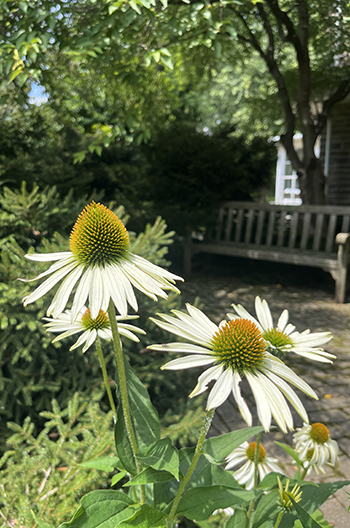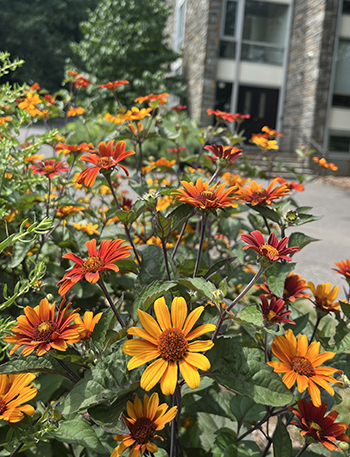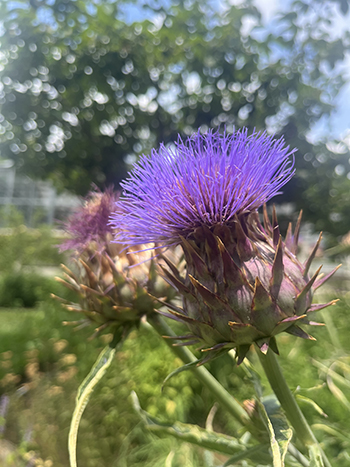
Plants of the Week: July 15, 2024
Guest Author: Annarose Klinger, 2024 Summer Intern

Echinacea purpurea ‘White Swan’ – purple coneflower
Nestled in an unassuming bed near Public Safety, the bright white petals of Echinacea purpurea ‘White Swan’ stand out against the dark green leaves of the Oriental spruce behind it. Commonly known as purple coneflower, Echinacea purpurea is native to central and eastern North America and hardy in USDA zones 3-8. Coneflower is an herbaceous perennial that is sun-loving and drought tolerant, making it a solid choice for Pennsylvania summers.
Purple coneflower, along with the rest of this week’s plants, belong to the family Asteraceae. Plants in this family have two different types of flowers; ray flowers and disc flowers. The center of Echinacea purpurea ‘White Swan’ is composed of bright orange to green disc florets that form a central cone surrounded by droopy, pure white, ray flowers. While its white petals may droop, Purple coneflower’s stems certainly do not, so Echinacea will stand upright and grow from 2-4 feet high. This species has had a long history of both ornamental and medicinal use and serves as a great addition to a sunny garden.

Heliopsis helianthoides var. scabra ‘Bleeding Hearts’ – false sunflower
At the top of the lower Biosteam, a bright drift of Heliopsis helianthoides var. scabra ‘Bleeding Hearts’ caught my eye. This has been a summer favorite since it began blooming in late June. ‘Bleeding Hearts’ has beautiful orange and yellow bicolor ray flowers that surround a central cone of brownish orange disc flowers.
Hardy to zone 3-9, H. helianthoides var. scabra ‘Bleeding Hearts’ will grow 3-4 feet tall and will spread up to 1.5 feet. False sunflower is a relatively low maintenance garden plant, but it may require staking if placed in a partly shaded area. Although drought tolerant, watering through dry spells may benefit the plant.
Variety scabra is more commonly used ornamentally than the straight species of Heliopsis helianthoides. It has hairier, rougher textured leaves and stems. While birds and bees love false sunflowers, deer tend not to, making it a good choice for gardens that experience deer-browse.

Cynara cardunculus – cardoon
Standing tall along the north side of the Cut Flower Garden, Cynara cardunculus is hard to miss. Growing up to 6 feet tall, this Mediterranean native will tower over the rest of the garden, making it a good choice for accents along the back or sides of a garden. Cardoon is an herbaceous tender perennial, hardy in USDA zones 7-10. This means it is not winter hardy in the Pennsylvania region. In the United States, cardoon is grown ornamentally and is known for its large, jagged, silvery leaves and its funky, thistle-like purple flowers. If given full sun and well-drained soil, Cynara cardunculus should be a low maintenance garden addition.





No Comments